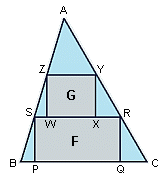
ABC is an acute-angled triangle with area 1. A rectangle F(PQRS) has its vertices on the sides of the triangle, with P and Q on BC, R on AC, and S on AB. Another rectangle, G(WXYZ), has its vertices on the sides of triangle ASR, with W and X on RS, Y on AS, and Z on AR.
What is the maximum total area of F and G?
(In reply to
re: Layman's Maths / we are not SQUARE!!! by Ady TZIDON)
I'd like to thank Ady for pointing out that it is not necessary to use squares, but i'd like to add that for the particular figures that i used in the example, squares are required.
if the height and base of the triangle were of differing lengths, then the "square" objects would in fact be rectangles and the calculation would still work.
|
|
Posted by Juggler
on 2004-03-03 11:54:25 |



